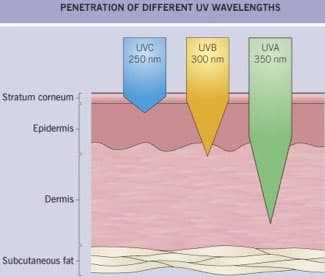Today we’re going to talk about the sun and the ways it affects our body. When the sun shines down on the earth and warms us, it contains a number of different types of light rays. Some of the light rays allow our bodies to make Vitamin D, which is an important nutrient for our bodies. Visible light is the most obvious light ray as it allows us to see, but another type of light ray is invisible yet very damaging to us. These are the ultraviolet known as UV rays, which themselves can be broken down into several parts.
The first type of UV rays are UVA rays. UVA rays accelerate skin aging (“A” for Aging). They have a long wavelength, which allows them to penetrate deeply into the skin through the outer part of the skin called the epidermis and down into the deeper part of the skin called the dermis, where they can fracture collagen and elastic fibers. These rays are present all day long, from sun-up to sun-down. They even have the ability to penetrate clouds and car windows.
The next type are UVB rays. These cause redness in the skin and are responsible for sunburn (“B” for Burning). They are most prevalent from 10:00 am to 4:00 pm and have a shorter wavelength that can’t penetrate as deeply into the skin.
The last type are UVC rays. These are toxic to life and absorbed by the ozone layer.
It’s important to understand that the sunscreens you use for yourself and your family need to protect against both UVA and UVB rays to more completely protect our skin from damage and that sunscreen needs to be reapplied throughout the day.
I hope you found this interesting and I invite you come back and watch again for our next Medical Minute.
